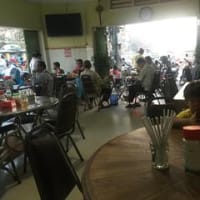神戸マラソンの日、家庭内暴力の章をえんえんと仕上げるのである。あーあ、マラソン出たかったなあ・・・来年がんばろう。
↓毎日通ってた麺屋の隣、はやってたので入ってみた

家庭内暴力は、学生たちが将来で一番「被害に遭う可能性が高い」暴力。カンボジアでは4人に1人の女性が被害にあってるわけで(この統計はWHOの調査結果次第ではもうすぐ覆されるかもしれない・・・・もっと高いかもしれない)、「家庭内暴力の被害にあったら自分を責めない」ことと、「社会そものに男性に暴力性を持たせるという問題があって、男性を加害者としてだけみるのはダメだ」という点を強調したい。男性については、別の章でマスキュニリニティとジェンダー暴力を書いたので、ジェンダー学としては、男性学もしっかり取り入れていて、なかなか悪くない構成だと思う。
Definition of DV varies across the countries, but most commonly, in includes physical violence, physiological violence, sexual violence and economic violence. DV is a pattern of abusive behavior in any relationship that is used by one partner to gain or maintain power and control over other intimate praters.
Physical violence: Hitting, kicking, beating, slapping, shoving, grabbing, pinching, biting, hair pulling, etc. This includes the denial of victim to seek for medical care, or forcing a partner to use alchohol/drug use against their will.
Emotional violence: Constant criticism, causing fear by intimidation, theretening physical hard to her/him or to children/family/relatives, destruction of family property, forcing isolation form family, diminishing one’ abilities, or controlling one’s relationship with her/his children, parents/siblings or relatives.
Sexual violence: Marital rape, attacks on sexual parts of the body, or threatening one in a sexually demeaning manner Coercing or attempting to coerce any sexual contact or behavior without consent.
Economic violence: Control over financial resources and access to money, forbidding one’s attendance to school or to employment. It also includes neglect by household head to supply for family members who are dependent on him/her.
上記は、自分の講義内容と、アメリカ司法省の定義を参考にした。http://www.justice.gov/ovw/domestic-violence
↓すごい量の麺、12元・・・食べ過ぎてお腹がもたれた・・・

なぜ、家庭内暴力なのか、という点について。
There are multiple reasons of why DV happens, but an important fact to remember is “victims has nothing to be blamed of”. No matter whatever “appropriate” reasons may be provided by a perpetrator, often times a man, there is no justifiable reason of the perpetration of DV. Also it is inevitable to understand dynamics of masculinities to understand the causes of DV from perpetrator’s side.
From academic researches, it came to become clear that DV may start when one partner feels the need to control and dominate the other. Abusers may feel this need to control their partner because of low self-esteem, extreme jealousy, difficulties in regulating anger and other strong emotions, or when they feel inferior to the other partner in education and socioeconomic background. Deep-rooted ideas about ‘appropriate masculinities” can also play a central role in the male perpetration of DV. Some men with very traditional beliefs may think they have the right to control women, and that women aren’t equal to men. Or, they need to show their ‘masculinities’ by using violence against their intimate partners. This was already examined in Chapter 12, so read it again to link masculinities and causes of DV.
↓上の麺を作ってるキッチン、次々とお客さんがやってくる
なぜ、家庭内暴力なのか、という点については、以下のサイトがかなり充実していたので、こちらを借りつつ。
http://www.nij.gov/topics/crime/intimate-partner-violence/pages/causes.aspx
以下はサイトからの引用、
Research supported by NIJ and others has identified some of the causes of, and risk factors for, intimate partner violence (often called "domestic violence"). Intimate partner violence has serious physical, psychological, economic, and social consequences.
- One in five women killed or severely injured by an intimate partner had no warning: the fatal or life-threatening incident was the first physical violence they had experienced from their partner. A woman's attempt to leave an abuser was the precipitating factor in 45 percent of the murders of women by their intimate partners (Block, 2003).
- Early parenthood is a risk factor. Women who had children by age 21 were twice as likely to be victims of intimate partner violence as women who were not mothers at that age. Men who had fathered children by age 21 were more than three times as likely to be abusers as men who were not fathers at that age. (Moffitt and Caspi, 1999).
- Although alcohol is not the cause of violence against women, a significant relationship exists between male perpetrator problem drinking and violence against intimate female partners. Severe drinking problems increase the risk for lethal and violent victimization of women in intimate partner relationships. More than two-thirds of the offenders who commit or attempt homicide used alcohol, drugs, or both during the incident; less than one-fourth of the victims did (Sharps et al., 2003).
- Severe poverty and its associated stressors increase the risk for intimate partner violence—the lower the household income, the higher the reported intimate partner violence rates (Carlson et al., 2000). Moreover, researchers found that reductions in benefits from Aid to Families with Dependent Children (AFDC) were associated with an increase in intimate partner homicides (Dugan, Nagin, and Rosenfeld, 2003).
- Intimate partner violence is linked with unemployment; one study found that intimate partner violence impairs a woman's capacity to find employment (Goodwin, Chandler, and Meisel, 2003). Another study of women who received AFDC benefits found that domestic violence was associated with a general pattern of reduced stability of employment (Meisel, Chandler, and Rienzi, 2003).
- Women who have experienced serious abuse face overwhelming mental and emotional distress. Almost half of the women reporting serious domestic violence also meet the criteria for major depression; 24 percent suffer from posttraumatic stress disorder, and 31 percent from anxiety (Goodwin, Chandler, and Meisel, 2003).
この章がおわったら、モンゴル料理を食べに行く!!と思って、神戸マラソンの写真をネットでみて励ましてもらいつつ、モンゴル料理めざして頑張るのである。




















